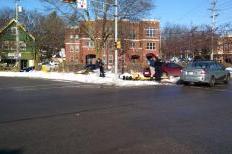






 When roads are slick, Metro should provide scaled down service to keep Madison moving (Courtesy photo).The Bus Stops Here is produced monthly by members of the Madison Area Bus Advocates
When roads are slick, Metro should provide scaled down service to keep Madison moving (Courtesy photo).The Bus Stops Here is produced monthly by members of the Madison Area Bus Advocates
Winter is upon us. As the challenges for getting around intensify, everyone learns to be more flexible with their schedules. One exception seems to be our local bus system, Madison Metro. Instead of flexing with the weather, the system simply shuts down. Total closures are now routine.
Madison Area Bus Advocates opposes unreliable bus service. Bus service, in our view, is not expendable. Ever. Unreliable bus service is not appropriate for a real city. Madison is home to world class medical & research centers. It is the seat of state and county government. Bus access is essential to the stature of the city.
Hospital workers must arrive at work, or people die. UW researchers must attend to their work or the people's millions go to waste. Emergencies multiply during severe weather events; 911 centers must continue to be staffed, yes, even during weather emergencies.
Thus, we disagree with a total bus system closure, ever. Indeed, given that major bottlenecks are usually caused by overconfident SUV drivers, there should be times the roads should be closed to all vehicles except emergency vehicles. And Metro, in our view, is an essential part of emergency transportation.
Buses are essential. Always.
Here's how our bus system can serve as an emergency transportation system when weather calls for it:
Develop a skeletal route system–The IceBus.
a) Plow priority routes (usually major arterials) and IceBus routes should be coordinated between Metro, Streets, Fire and other emergency departments.
b) Avoid major hills or other tough to navigate topography; stops should never be at the bottom of, or on the slope of, a hill or at a steeply crowned street. The skeletal system should travel along the very largest, most plowed, flattest roads only, for example: East Washington, University Avenue, Park Street, etc. Notorious choke-points like the East Gorham Hill, should be eliminated above all.
c) Train bus drivers to avoid going all the way into the slushy curb area at stops so that the bus can more readily gain speed.
d) Space bus stops, drastically: distances of 1 mile in suburban areas, and half mile in the university/capital area. This accounts for the difficulty of getting back up to speed after stopping even on flat ground.
e) Differentiate IceBus stops vs. Snow Emergency closures. There could be a little snowflake symbol on the sign for IceBus stops. Cancelled stops could display a snowflake with a red slash through it. That way, people can plan in advance as to which stops will be valid during weather emergencies.
f) Prioritize timely, easily accessible and multi-channel (i.e. online, via phone, etc.) information on what is available, where and when – this would require year-round and well-publicized notice of "in an emergency you can find Metro bus information at...."
g) Ensure priority boarding for public health and safety personnel, and passengers with medical conditions/necessities requiring transportation short of an ambulance.
h) Coordinate with 911 to provide Metro transit information and options for distressed callers as appropriate.
i) Staff an emergency operations center, because emergencies never end up exactly as forecast and a lot of special problems arise that require changes in operational plans to meet actual storm conditions. Center staff is to include personnel from Streets, Traffic Engineering, MPD, MFD, and, METRO and other relevant agencies. (Metro plans should be integrated for operating area transportation systems during other emergencies as well; i.e., METRO should always be a basic component of all emergency planning beyond just weather emergencies.)
j) Minimize drivers' difficulty in arriving to work: provide emergency dormitory facilities (cots, etc.) on-site at the bus barns. Provide incentive pay for providing this service. Alternately, provide “walking mortgages” or rent subsidies for drivers who live within walking distance of the bus barns.
k) Purchase buses that have transmission systems that are more amenable to starting up in slick conditions.
l) Outfit buses on the most problematic routes with chains or carbide studs for this emergency service.
m) Explore using smaller, paratransit-style buses during the emergency to find out if they perform better in snowy/icy conditions.
This routing system will get most of Madison's population to within one mile of a bus line, and within a few blocks of the regional workplaces (university, state government, hospitals). A few blocks is better than a few miles.
A scaled-back, skeletal system also buys the system time. As drivers are able to make their way to work, routes can come back online in stages, and Metro's website can provide updates as to which lines are coming back up.
The IceBus proposal is by no means exhaustive; it is a mere point of departure for further improvements. Bus drivers, shift supervisors, city plow drivers and supervisors, first responders, riders, and others should all be invited to help develop system that runs no matter the weather, no matter the emergency. In other words, this is just IceBus 1.0 working toward 2.0 and beyond.
|
|
|
Welcome to the Madison Commons, a website designed to provide news and information about all of Madison's neighborhoods and a crossroads for the discussion of community issues. The name comes from the idea of a village commons, a place for news, talk, debate, and some entertainment, too, that's open to everyone.
All rights reserved. Read more about the Madison Commons and its partners.

